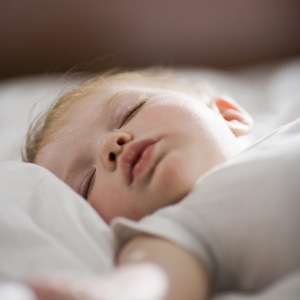Keep your baby on the back WITHOUT a baby sleep positioner
Author Name: Heidi Holvoet, PhD
Medical fact-check: Dr Leah Alexander, M.D., F.A.A.P.
A baby sleep positioner, baby wedge, or bassinet wedge is not safe and forms a potentially fatal risk
so do not use any, ever. The CPSC and FDA warn
that babies have died after getting stuck between the wedges and the
crib side.
Let's find out why that is + learn how to keep baby on the back without
a
dangerous
holder
in the crib.

Along with all other crib
safety and SIDS guidelines, we should always put baby on their back
to sleep: it's the single safe
baby
sleeping position
. Since parents have been advised to keep baby on
the back at the end of
the 1980's, SIDS rates have decreased a lot (!). And it still the
standard recommended way to sleep.
But, it's
never a good
idea to try and keep your baby on the back with a sleep positioner
.
You probably have seen these
rolls
or baby wedges in different shapes and sizes. And you may wonder are bassinet wedges safe? No, they're absolutely not.
Our mothers and grandmothers used them (or a rolled-up towel) to keep
us sleeping on
the side (which was sometimes still recommended in those days). You can
still buy them or even find them included with a so-called in-bed
mini cosleeper which I no longer recommend.

Both the
CPSC baby sleep positioner report
and the
FDA report
state that
several babies have suffocated after rolling within
the infant sleep positioner and/or getting stuck
between one of the
wedges and the crib side. A recall is not mentioned but they do
warn to stop using any sleep positioner:
"To date, there is no
scientifically sound evidence
that infant sleep positioners prevent SIDS,” said Dr. Joshua
Sharfstein, FDA Principal Deputy Commissioner and a pediatrician. “
We
want to make sure parents, health care professionals, and childcare
providers understand the potential risk of suffocation and
stop using
infant sleep positioners."
So there is no way we can take this risk. Still you might need to find a
way to keep your baby safely on their back.
What if baby rolls over onto their tummy while asleep?
First of all, when baby is put to sleep on
the back in an empty crib (as recommended) and then rolls over, the
risk of suffocating is lower than with a baby sleep positioner in the
crib. Exactly
because there is no extra
material to get stuck in.
SIDS
prevention guidelines
advise for you to be near your baby (supervise
closely, ideally sleep in the same room) to monitor carefully. In particular in the first year, with baby in their own crib or
cosleeping safely. This way you're there to monitor your baby and can roll them over when necessary.
So putting down on the back in an empty crib is crucial.
During transition times (when learning to roll over), a well-adapted, right-size, right-temperature (all of these super important for safety!!!)
baby
sleeping bag
(also called wearable blanket) helps some to keep baby on their back, safely. That is because it makes rolling over just a
little bit more difficult.
Once your baby rolls back and forth easily, you will still want to put them on the back to sleep whenever you place them in the crib. Some parents stay near and resolve to keep turning them around. Most experts agree though that this isn't necessary (see external links below).
But once your baby is
so agile and strong to roll back and forth easily, and you are
confident that they'll also be able to do it while asleep, the risk
from being on the tummy decreases, as this
comment by Dr Sears
and
the answer to the rolling over question
on Safe to Sleep state.
Back to all hand-picked product reviews

Baby waking every hour?
by Heidi Holvoet, PhD

Sleep schedules by age
by Heidi Holvoet, PhD

Separation Anxiety
by Heidi Holvoet, PhD

Crib safety guidelines
by Heidi Holvoet, PhD

Why does my baby wake up every hour?
by Heidi Holvoet, PhD


